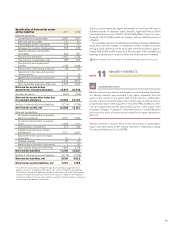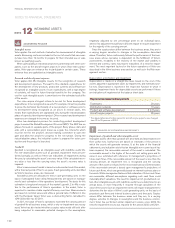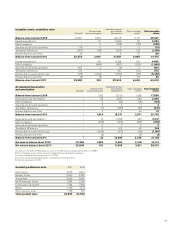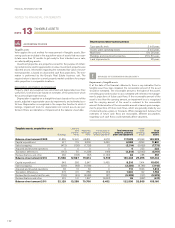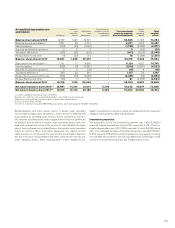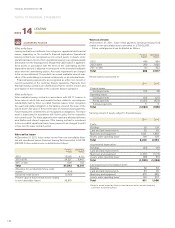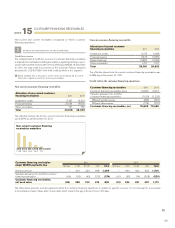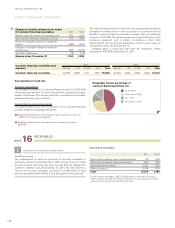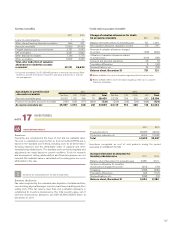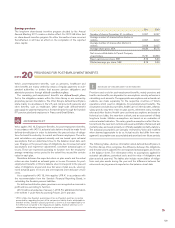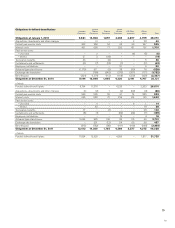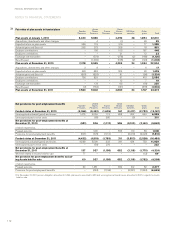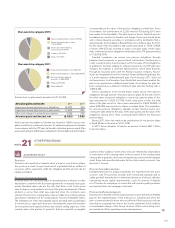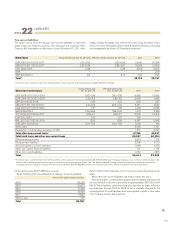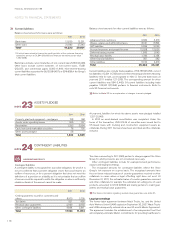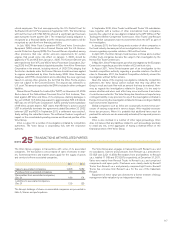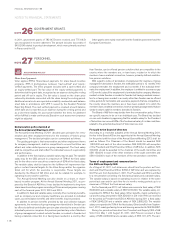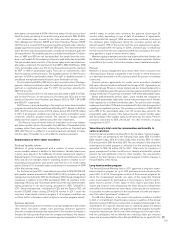Volvo 2011 Annual Report Download - page 113
Download and view the complete annual report
Please find page 113 of the 2011 Volvo annual report below. You can navigate through the pages in the report by either clicking on the pages listed below, or by using the keyword search tool below to find specific information within the annual report.
Earnings per share
The long-term share-based incentive program decided by the Annual
General Meeting 2011 creates a dilution effect. For 2010 AB Volvo had
no share-based incentive program. No other transactions have occurred
that affected, or will have an effect on, the compilation of the reported
share capital.
2011 2010
Number of shares, December 31, in millions 2,027 2,027
Average number of shares before dilution in
millions 2,027 2,027
Average number of shares after dilution in
millions 2,028 2,027
Average share price, SEK 94.84 85.75
Net income attributable to Parent Company
shareholders 17,751 10,866
Basic earnings per share, SEK 8.76 5.36
Diluted earnings per share, SEK 8.75 5.36
PROVISIONS FOR POST-EMPLOYMENT BENEFITS
20
NOTE
Volvo’s post-employment benefits, such as pensions, healthcare and
other benefits are mainly settled by means of regular payments to inde-
pendent authorities or bodies that assume pension obligations and
administer pensions through defined-contribution plans.
The remaining post-employment benefits are defined-benefit plans;
that is, the obligations remain within the Volvo Group or are secured by
proprietary pension foundations. The Volvo Group’s defined-benefit plans
relate mainly to subsidiaries in the U.S. and comprise both pensions and
other benefits, such as healthcare. Other large-scale defined-benefit
plans apply to salaried employees in Sweden (mainly through the Swedish
ITP pension plan) and employees in France and Great Britain.
SOURCES OF UNCERTAINTY IN ESTIMATES
!
Provisions and costs for post-employment benefits, mainly pensions and
health-care benefits, are dependent on assumptions used by actuaries in
calculating such amounts. The appropriate assumptions and actuarial cal-
culations are made separately for the respective countries of Volvo’s
operations which result in obligations for postemployment benefits. The
assumptions include discount rates, health care cost trends rates, inflation,
salary growth, long-term return on plan assets, retirement rates, mortality
rates and other factors. Health care cost trend assumptions are based on
historical cost data, the near-term outlook, and an assessment of likely
long-term trends. Inflation assumptions are based on an evaluation of
external market indicators. The salary growth assumptions reflect the his-
torical trend, the near-term outlook and assumed inflation. Retirement and
mortality rates are based primarily on officially available mortality statistics.
The actuarial assumptions are annually reviewed by Volvo and modified
when deemed appropriate to do so. Actual results that differ from man-
agement’s assumptions are accumulated and amortized over future periods.
The following tables disclose information about defined-benefit plans in
the Volvo Group. Volvo recognizes the difference between the obligations
and the plan assets adjusted for unrecognized actuarial gains and losses
in the balance sheet. The information refers to assumptions applied for
actuarial calculations, periodical costs and the value of obligations and
plan assets at year-end. The tables also include reconciliation of obliga-
tions and plan assets during the year and the difference between fair
values and carrying amounts reported on the balance-sheet date.
ACCOUNTING POLICY
Volvo applies IAS 19, Employee Benefits, for post-employment benefits.
In accordance with IAS 19, actuarial calculations should be made for all
defined-benefit plans in order to determine the present value of obliga-
tions for benefits vested by its current and former employees. The actu-
arial calculations are prepared annually and are based upon actuarial
assumptions that are determined close to the balance-sheet date each
year. Changes in the present value of obligations due to revised actuarial
assumptions and experience adjustments constitute actuarial gains or
losses. These are expensed according to function over the employees’
average remaining service period to the extent they exceed the corridor
value for each plan.
Deviations between the expected return on plan assets and the actual
return are also treated as actuarial gains or losses. Provisions for post-
employment benefits in Volvo’s balance sheet correspond to the present
value of obligations at year-end, less fair value of plan assets, unrecog-
nized actuarial gains or losses and unrecognized unvested past service
costs.
As a supplement to IAS 19, Volvo applies UFR 4*, in accordance with
the recommendation from the Swedish Financial Reporting Board, in
calculating the Swedish pension liabilities.
For defined contribution plans, premiums are recognized as incurred in
profit and loss according to function.
IAS 19 will be amended as of January 1, 2013. For additional information,
refer to Note 1 under New Accounting Policies 2011 and later.
* UFR 4 states how Swedish special payroll tax and Swedish yield tax should be
accounted for regarding the part of the net pension liability that is attributable to
Swedish entities. Swedish special payroll tax is shown as a receivable/liability on
the difference compared to the legal pension liability. Swedish yield tax is con-
sidered when estimating expected return on plan asset.
109


